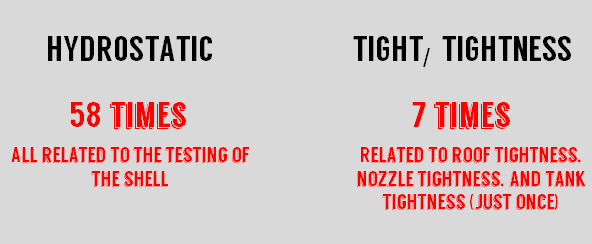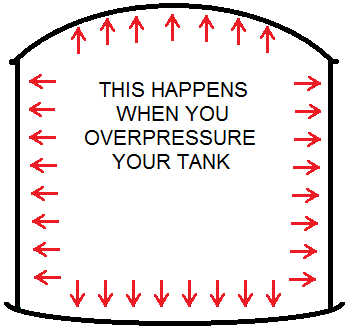Is the hydrostatic test a tightness test only?
By Carlos F Molina
Today´s artice is about hydrostatic testing in tanks. In my workplace, it became a common ocurrence for the people to say that “the hydrostatic test in a tank is just a tightness test”. Some gals say that “the most important thing to do with hydrostatic testing is settlement measurement”. This illustrates that not everybody understands hydrostatic testing fully.
In this article, we will see how the hydrostatic test is made for various types of tanks and which parts of a tank are evaluated with an hydrostatic test.
THE THREE MAIN PURPOSES OF HYDROSTATIC TESTING
Hydrostatic testing in tanks has 3 main purposes, according to…. me
- Check that the tank is leak tight
- Check that the welds can stand operational conditions
- Check foundation settlement
[adToAppearHere]
There is this greater purpose of checking the tank as a whole against opeartional conditions. Happens that the first two are intertwined, and neccessary. Foundation settlement measurements, on the contrary, are not mandatory in all of cases. As the standard says, the manufacturer shall be responsible for “taking settlement measurements when not waived by the purchaser on the Data Sheet, Line 14” (API 650 7.3.6.2). There are several cases where this can happen in new tanks: where settlement is not expected or when a new smaller tank is located above an used foundation that has shown to be resistant to settlement.
“HYDROSTATIC” vs “TIGHTNESS”
It is an “hydrostatic test” or a “tightness test”? The following definitions can be useful when understanding this issue:
Tightness – Of such close construction as to be impermeable.
Hydrostatic – relating to fluids at rest or to the pressures they exert or transmit; “hydrostatic pressure”
The first paragraph where the word “hydrostatic” appears in the API 650 standard is in 5.2.1, “Loads”. That´s right, hydrostatic loading is associated with thickness calculations of the shell of a tank.
The word “hydrostatic” is used 58 times in the main part of the standard, all related to the testing of the shell. The word “tight” appears 7 times in the main part of the standard. Of those 7, just once it has to do with tank tightness. Actually, it is mostly associated with the need of some roofs to be gas-tight. That´s the first clue that demostrates that the test is “hydrostatic” in nature.
Hydrostatic testing demonstrates fitness for service of a tank with minimal risk of failure, given that it represents the harsher condition the tank will have during operation. The welds most affected by static pressure are, obviously, vertical welds. However, consider tanks with internal pressures, in which, gases occupy the space above liquid level. This are usually proccess tanks, in which a welded dome or umbrella roof is used to contain the internal pressure of the vapor space above the liquid´s surface. In this tanks, shell-to-bottom and roof-to-top-angle welds must show they can withstand the forces exerted by gas pressure.
[adToAppearHere]
But if were only going to test for leaks, that can be done with gases and vacuum boxes, right? Well, there are many types of tanks and roofs, not mentioned here in this article, and they are tested differently. However, testing leaks using gases up to the pressure that can be reached in the bottom of a tank when filled with liquid, would be extremely dangerous. If we were going to test a gas-tight tank with this pressure, the uplift to the roof would be greater than the weight of the roof plus the weight of the shell, and the welds can be broken and the tank deformed. And vacuum boxes usually cannot reach the 15 or 20psi needed to test shell-to bottom welds, and they cannot induce hoop stresses to the vertical welds.
Liquids are the only way to test the tank in the same way that they will operate. And they exert “hydrostatic” force to the tank.
HYDROSTATIC TESTING FOR DIFFERENT TANKS
ATMOSPHERIC OPEN TOP TANKS. Tanks without a roof, tanks with a geodesic dome roof, or tanks with an internal or external floating roof. In this tanks, the hydrostatic test height is the design liquid level. API 650 7.3.5
TANKS WITH SMALL INTERNAL PRESSURES UP TO 2,5PSI WHERE INTERNAL PRESSURE DOESN´T EXCEED THE WEIGHT OF THE ROOF PLUS SHELL PLUS SHELL PLUS ATTACHED FRAMING. This type of tank has to be tested with water 2 inches above the top angle and vacuum testing roof welds or testing the tank with a pressure not exceeding the weight of the roof plates.
TANKS WITH SMALL INTERNAL PRESSURES UP TO 2,5PSI WHERE INTERNAL PRESSURE EXCEEDS THE WEIGHT OF THE ROOF PLUS SHELL PLUS ATTACHED FRAMING. According to Annex F, F.7.5, these tanks should be tested with water up to the design liquid level, and with gas pressure 1,25 times the design pressure. Having anchorage bolts in this type of tanks can help in avoiding bottom deflection (the need for anchorage depends in multiple conditions, not only internal pressure).
SUMMARY
I always find myself correcting people that say that “an hydrostatic test is just a tightness test”. But if you read the standard toroughly, it can help you understand better the issue of hydrostatic testing. And you can compare with other standards. For example, ASME B31.3 calls the test an “hydrostatic leak testing”, acknowledging both components of the test.
Thank you so much for your time.



Latest comments
Sooo happy to know. Yes, I am preparing my next article. Thanks
- Carlos F. MolinaSuccessfully cleared API-653 exam. Your site helped me a lot. Thank you and keep updating.
- VinothkannanThanks for the tip. I will send you som einfo this week. Meanwhile, you can check this link https://apiexam.com/impact-testing-in-tanks-for-the-api-653-exam/
- Carlos F. MolinaDear Mr.Carlos By Nov-20 I had appeared API-653 re-exam.15 questions asked about Brittle Fracture considerations during Hydro test.So I need more related to this topic
- Navaneethan S